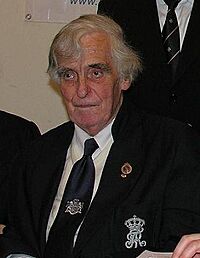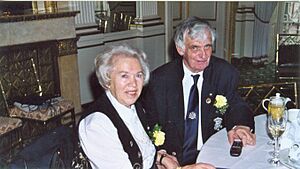Albert von Sachsen (born 1934) facts for kids
Quick facts for kids Albert |
|||||
|---|---|---|---|---|---|

The Margrave of Meissen
|
|||||
| Head of the Royal House of Saxony (disputed) | |||||
| Tenure | 23 July 2012 – 6 October 2012 | ||||
| Predecessor | Maria Emanuel | ||||
| Successor | Rüdiger | ||||
| Born | 30 November 1934 Bamberg, Upper Franconia, Bavaria, Weimar Republic |
||||
| Died | 6 October 2012 (aged 77) Munich, Bavaria, Germany |
||||
| Burial | 12 October 2012 Friedrichstadt (Dresden) |
||||
| Spouse | Elmira Henke | ||||
|
|||||
| House | Wettin | ||||
| Father | Friedrich Christian, Margrave of Meissen | ||||
| Mother | Princess Elisabeth Helene of Thurn and Taxis | ||||
| Religion | Roman Catholicism | ||||
Prince Albert Joseph Maria Franz-Xaver of Saxony (born November 30, 1934 – died October 6, 2012) was an important member of the Royal House of Saxony. He was also a German historian. Albert was the youngest son of Friedrich Christian, Margrave of Meissen and Princess Elisabeth Helene of Thurn and Taxis. He became the head of the Royal House of Saxony for a short time after his older brother, Maria Emanuel, Margrave of Meissen, passed away.
Contents
Life of Prince Albert
Early Education and Family Life
Albert grew up and went to school in Austria. He attended the Federal Gymnasium, which is a type of high school, in Bregenz. He finished his studies and passed his final exams, called the matura, in 1954.
After his schooling, Albert and his family moved to Munich, Germany. His mother's relatives, the Thurn und Taxis family, helped them settle there.
University Studies and Research
In Munich, Albert went to the Ludwig Maximilian University. He first studied macroeconomics, which is about how large economies work. Later, he changed his focus to history and ethnography. Ethnography is the study of human cultures and societies.
On February 13, 1961, he earned his PhD, which is a high university degree. His special research was about his great-great-grandfather, King John of Saxony. He studied how King John reformed business laws in Saxony.
Starting a History Group
On January 30, 1960, Albert helped start a group called the "Study group for Saxon history and culture." He founded it with his parents, his brother Maria Emanuel, and other people interested in history. This group became one of the biggest historical societies in West Germany.
After finishing his university studies, Albert worked as a historian. He focused on the history of the Duchy of Saxony and the Kingdom of Saxony. He was especially interested in how Saxony and Bavaria were connected throughout history.
Public Involvement and Return to Saxony
Albert was also involved in public life. For some time, he was the vice president of the "Association of Central Germans." In 1972, he joined the "Central German Culture Council." Here, he worked to represent the interests of the Free State of Saxony.
In the summer of 1982, Albert was able to visit Saxony again for the first time since he was young. He visited again in 1983 and 1985. Then, for reasons that are not clear, he was not allowed to enter the German Democratic Republic (East Germany) until 1989/1990.
On January 22, 1990, he took part in a Monday demonstration in Dresden. These were peaceful protests that helped bring about the end of communist rule. He was asked to speak to the crowd. He talked about rebuilding Saxony and ended by saying, "Long live Saxony, Germany, Europe and the western-Christian culture."
After the German reunification, Albert tried to get back some of his family's old properties.
Marriage and Family Life
Prince Albert married Elmira Henke in two ceremonies. They had a civil ceremony on April 10, 1980, in Munich. Two days later, on April 12, 1980, they had a religious ceremony at the Theatine Church, also in Munich.
Elmira helped Albert with his historical research. She was especially good at studying topics related to different cultures. Albert and Elmira did not have any children.
Royal Succession Dispute
The leadership of the Royal House of Saxony has been a topic of disagreement within the Saxon Royal Family. This disagreement happened because the previous head of the family, Maria Emanuel, Margrave of Meissen, and his brothers did not have children who were considered part of the royal family according to old rules.
Maria Emanuel first thought about his nephew, Prince Johannes, as his heir. Johannes was the son of Maria Emanuel's youngest sister. But Prince Johannes died young.
Then, Maria Emanuel considered another nephew, Alexander Afif, as his heir. Alexander was the son of Maria Emanuel's sister Princess Anna. However, Anna's marriage was not considered an "equal marriage" by the traditional laws of the House of Saxony. This meant her children might not have royal rights.
In 1997, Maria Emanuel suggested Alexander Afif as his heir. A document was signed by many family members agreeing to this. Two years later, Maria Emanuel officially adopted Alexander Afif.
However, in 2002, Prince Albert and two other princes changed their minds and no longer supported this agreement. Prince Albert believed that Prince Rüdiger of Saxony and his sons were the true heirs to continue the main line of the family.
When Maria Emanuel passed away in July 2012, Prince Albert briefly took over as the head of the Royal House of Saxony. Prince Albert died a few months later, on October 6, 2012, at the age of 77.
After Albert's death, Prince Rüdiger became the head of the house. This was based on a plan that Albert had made before he passed away.
Publications by Prince Albert
Prince Albert was a dedicated historian. He wrote many books and papers about the history of Saxony and other related topics. Here are some of his published works:
- Die Reform der sächsischen Gewerbegesetzgebung (1840–1861) (His PhD thesis)
- Dresden
- Leipzig und das Leipziger Land
- Die Albertinischen Wettiner — Geschichte des Sächsischen Königshauses (1763–1932) (History of the Saxon Royal House)
- Weihnacht in Sachsen (Christmas in Saxony)
- Die Wettiner in Lebensbildern (The Wettins in Biographies)
- Die Wettiner in Sachsen und Thüringen (The Wettins in Saxony and Thuringia)
- Das Haus Wettin und die Beziehungen zum Haus Nassau-Luxemburg (The House of Wettin and its relations with the House of Nassau-Luxemburg)
- Bayern & Sachsen — gemeinsame Geschichte, Kunst, Kultur und Wirtschaft (Bavaria & Saxony — shared history, art, culture, and economy, with Elmira of Saxony and Walter Beck)
- Königreich Sachsen: 1806–1918; Traditionen in Schwarz und Gelb (Kingdom of Saxony: 1806–1918; Traditions in Black and Yellow)


